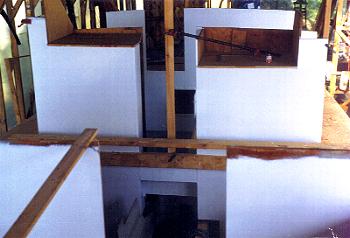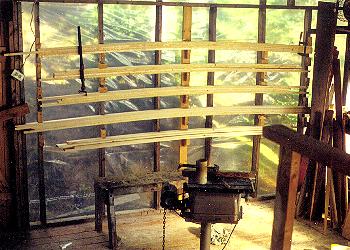Building the Glen-L Yukon, Part 2
by Wayne Milner
Page 2
 The major bulkheads were installed, fiberglassed, and painted before the cabin sides were installed. |
I made the two water tanks (about 100 gallons each) out of plywood and fiberglassed them on the inside. They are not integral with the hull. I thought it was agony fiberglassing the inside of the tanks, and am not interested in doing it again. My recommendation is to buy ready-made tanks or have somebody else fabricate them.
The Glen-L plan shows water tanks adjacent to the fuel tanks in the midship area. To at least partially compensate for shifting the water tanks to the aft end, I moved the fuel tanks forward a bit, and also installed the engine a bit forward of the location shown on the plans. All of this worked out pretty well. The trim changes slightly as water is used out of the tanks, but not enough to be of concern.
I spent a long time thinking about the fuel tanks. (Having tanks fabricated by an outside party costs money.) I considered various shapes and materials, and finally decided to have cylindrical tanks made out of 1 1/4 inch thick 5052 aluminum alloy. I have two tanks, each 30 inches in diameter by 6 feet long. The tanks were fabricated by a local welding shop. The tanks were tested to an 8-foot head, and I was present at the time of the test.
The ends of the tanks were "bumped"; in other words, given some curvature to prevent them from "oil canning". At the time of the pressure test, a dial gauge was set up at the center of one end of the tank to measure any deflection. Deflection was 0.076 inch, which was felt to be minimal and of no consequence.
 The coach roof beams were laminated in this jig built on one wall of the temporary shelter. |
I think cylindrical tanks have some advantages. First, there is less welding involved than with a tank made to fit the hull shape. Second, access above, behind, and under the tank is better than it is with a shaped one. Third, water won't lay on top of the tank, thereby reducing the possibility of corrosion. And finally, when the boat is rolling in a seaway, the fuel makes a nice gentle motion up the curved sides of the tank rather than slapping against a straight side.
One disadvantage of cylindrical tanks is that some capacity is lost in the areas where the corners of a square or rectangular tank would be, but this boat has lots of space for everything. Also, it is probably a little more difficult to block and tie down a cylindrical tank that it is a rectangular one.